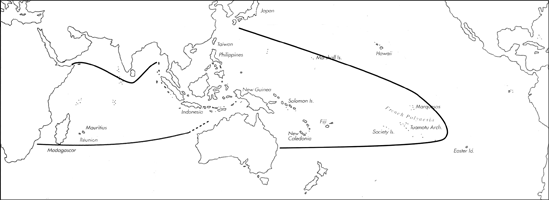Range: S. and E. Africa to Marshall Is. and Tuamotu Archipelago; absent from Red Sea, India and Sri Lanka.
Description: Medium-sized to moderately large, moderately solid to solid. Last whorl conical to conoid-cylindrical, sometimes slightly ovate in Pacific shells; outline almost straight to evenly convex. Shoulder angulate to subangulate, moderately to strongly tuberculate. Spire of moderate height, outline slightly concave to slightly convex. Larval shell of 4 or more whorls, maximum diameter 0.80-0.85 mm. Postnuclear spire whorls tuberculate. Teleoconch sutural ramps flat to slightly concave, with 1 increasing to 6 spiral grooves; grooves finer and sometimes obsolete in late whorls. Specimens with heavily granulose evenly spaced ribs around entire last whorl intergrade with specimens with widely set, weak granulose ribs around basal fourth of last whorl.
| Shell Morphometry | ||
|---|---|---|
| L | 35-61 mm | |
| RW | 0.20-0.48 g/mm | |
| (-Indian Ocean Shells; -Pacific Shells (0.14-0.34 g/mm) (L35-54 mm)) | ||
| RD | 0.57-0.67 | |
| (-Indian Ocean Shells; -Pacific Shells (0.54-0.62)) | ||
| PMD | 0.82-0.91 | |
| (-Indian Ocean Shells; -Pacific Shells (0.73-0.91)) | ||
| RSH | 0.12-0.23 | |
Ground colour white. Last whorl often tinged with pale pink or violet, with dark brown, irregularly shaped or axial blotches within adapical and abapical third. Blotches variable in size and number, sometimes fusing into 2 spiral bands. Closely spaced spiral rows of dark brown dashes and dots extend from base to shoulder. Larval whorls white. Teleoconch sutural ramps with sparse brown dots. Aperture nearly white or pale yellow to orange behind a white marginal zone.
Periostracum yellowish brown, thin, translucent, almost smooth.
Dorsum of foot white to pale yellow, often with a dotted black or dark brown pre-marginal line; anterior part with brown or black markings laterally and centrally; a small black fleck beneath operculum. Sole of foot white to yellow. Rostrum yellow. Tentacles yellow, tipped with darker yellow or brown. Siphon pale yellow with a light brown to black ring somewhat back from the tip; distal end sometimes darker and sparse mottling may replace transverse ring laterally (Chaberman, pers. comm., 198 1; Pearson, unpubl. observ.; Kohn, unpubl. observ.) (Pl. 74, Fig. 6; P1. 77, Fourth row, right).
Radular teeth with an adapical barb opposite a long second barb (or blade?); serration terminating in a cusp; central waist and small basal spur present (Nybakken, 1990).
Habitat and Habits: Intertidal to about 30 m; in Philippines, dredged to 240 m. On coral reef platforms and fore-reefs, in or under dead coral, on limestone bench and in sand often beneath coral rocks. Egg capsules are deposited in parallel rows on the underside of coral rocks and affixed to the substratum by confluent basal plates. Capsules 8-1 1 x 6-8 mm, each containing 1,700-2,700 eggs; number of eggs per spawn 63,000-81,000. Egg diameter of 160-166 ┬Ám predicts a minimum pelagic period of 26-27 days (Kohn, 1961b; Cemohorsky, 1964; Perron & Kohn, 1985).
Discussion: The shells of C. varius are very distinctive and cannot be confused with any Indo-Pacific congeners. The lectotype of C. varius is of the more slender conoid-cylindrical form occurring more frequently in Pacific populations, while the more conical form is commoner in Indian Ocean populations.

C. varius Range Map
This section contains verbatim reproductions of the accounts of 316 species of Conus from the Indo-Pacific region, from Manual of the Living Conidae, by R÷ckel, Korn and Kohn (1995). They are reproduced with the kind permission of the present publisher, Conchbooks.
All plates and figures referred to in the text are also in R÷ckel, Korn & Kohn, 1995. Manual of the Living Conidae Vol. 1: Indo-Pacific Region.
The range maps have been modified so that each species account has it own map, rather than one map that showed the ranges of several species in the original work. This was necessary because each species account is on a separate page on the website and not confined to the order of accounts in the book.